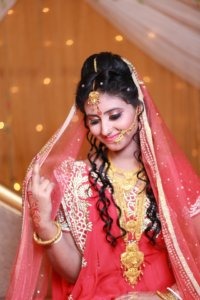5 Hindu Wedding Traditions You Should Know
 Weddings are a wondrous occasion; a time of celebration, as two individuals join together in a commitment ceremony where they pledge their lives to each other. While all weddings are beautiful in their own right, regardless of venue or budget, there’s nothing quite like the lavishness typical of the Hindu matrimonial celebration.
Weddings are a wondrous occasion; a time of celebration, as two individuals join together in a commitment ceremony where they pledge their lives to each other. While all weddings are beautiful in their own right, regardless of venue or budget, there’s nothing quite like the lavishness typical of the Hindu matrimonial celebration.
This may be due to the ceremonies typically being held in opulent Hindu wedding venues, taking place over the course of several days. But another important factor that most assuredly comes into play is that the Hindu wedding is one steeped in the tradition of the oldest continuing religion on the planet. With more than 4,000 years to cultivate these traditions and rituals, the resulting ceremonies are sights to behold. Here are five Hindu wedding traditions that help make these such magical occasions.
Ganesh Poojan
The Lord Ganesh, also known as Ganesha, is probably the most well-known symbol of Hinduism. The diety, depicted as a having a humanoid body with an elephant’s head, is the god of wisdom and salvation. During this ceremony, which kicks off the wedding festivities, friends and family pray to Ganesh, calling upon him to assure a ceremony free of problems.
Kanyadan
This solemn ceremony is a symbolic means for Hindu parents to formally “give away” their bride to the groom-to-be. The bride is led to a mandap (a temporary, indoor gazebo of sorts), where her groom awaits, along with her parents. The happy couple’s feet are washed with milk and water, in an act said to purify them before the celebration. Then, the bride’s mother pours water over the father’s hands, which trickles to the hands of the bride and groom, completing the ritual.
Hastamilap
In this act, while a priest prays aloud, the bride and groom’s right hands are bound together with a single thread multiple times. This symbolizes the strong, everlasting bond that their marriage should mirror.
Marriage Ceremony
The actual wedding ceremony is rife with symbolism. The happy couple sits alongside an agni (holy fire), which represents life and purity. The attending priest recites from holy scripture before the couple begins to circle the fire four times, a practice called mangalfera; while doing this, they exchange vows of duty, fidelity, love, and respect. Members of both the bride’s and groom’s family make offerings directly into the fire, and then the marriage is finally solidified in an act called saptapadi. This final piece of the puzzle involves making seven vows, usually spoken in Sanskrit and is a must for any traditional Hindu wedding.
Dhruvadarshan
This symbolic act comes at the conclusion of the ceremony and involves the priest directing the new couple’s eyes toward the North Star. This star represents stability and reliability; in its acknowledgment, that same unwavering nature of the star is transferred onto the bride and groom’s marriage.
No matter which of the many Hindu wedding venues is chosen, with such deeply personal, long-lasting traditions built in to these ceremonies, it’s easy to see how these celebrations are of particular beauty. Modernity hasn’t changed the importance of centuries-old ritual, making for exceptionally awe-inspiring unions. Call 215-918-8409 to meet with our South Asian wedding specialist and see your unique wedding event begin to take shape.


